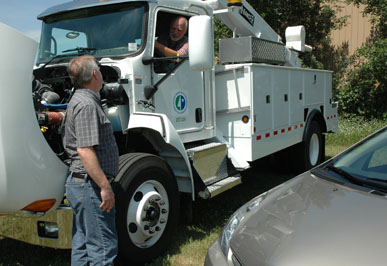|
By Craig Wilkins

A Ford Escape hybrid displays this logo that promotes the state's initiatives to use alternate-fuel vehicles. Photo by Craig Wilkins |
When Mn/DOT’s new bucket lift truck parks and hoists a technician to repair a light or a traffic signal, something unusual happens.
Its engine stops running.
Instead of idling, the 6.7-liter diesel engine shuts down. Power to operate the truck’s electric and hydraulic systems comes from a lithium ion battery mounted under the chassis.
The battery is charged by a generator that transforms mechanical energy produced during braking into electrical energy.
The truck can operate on battery power alone for about 2.5 hours until a recharge is needed.
The truck is the agency’s first diesel-electric hybrid vehicle. The hybrid version of the truck gets about 10 miles per gallon of fuel compared with 5 to 6 miles per gallon for the standard version.
The 3.5 ton-rated Kenworth joined Mn/DOT’s fleet in June. It’s operated by the Electrical Services Section based at Fort Snelling.
Randy Cameron, a supervisor at Central Shop, said the truck is the newest addition to Mn/DOT’s growing stable of hybrid vehicles.
The fleet now includes three Ford Escapes, one Toyota Prius and a Chevrolet Tahoe SUV.

Randy Cameron (at left) and Dave Mitton (in truck), Central Shop supervisors, check out Mn/DOT's first diesel-electric hybid truck shortly after it went into service with the Electric Services Section at Fort Snelling. Photo by Craig Wilkins |
The truck works much like the lighter, gas-electric hybrids.
Its diesel engine stops running just as the smaller hybrids shut down their gas engines when stopped.
The gas engines restart when the vehicle moves, getting a power boost from their electric motors. The motors provide large amounts of torque, enabling the hybrids to accelerate briskly or pass without using extra fuel.
John Scharffbillig, fleet manager, Maintenance, said Mn/DOT continues to evaluate the hybrids’ performance to determine their effectiveness.
Initial findings are promising, he said, noting the Escape hybrid gets about 35 miles per gallon, about 10 more than a standard Escape.
Two of the Escapes, he said, are being retrofitted to use plug-in batteries.
Plug-in batteries can operate at a higher charge level, providing a stronger power assist for longer periods of time. Plug-in hybrid batteries are charged by plugging them into a standard outlet when the vehicle is not in use.
The Toyota Prius averages 41 miles per gallon in service as a pool vehicle for Central Shop staff.
Steve Lund, state maintenance engineer, said the evaluations are being made under the umbrella of the Governor’s Next Generation Energy Initiative.
Its mandates include cutting gasoline use by 25 percent and diesel fuel consumption by 10 percent by the year 2010.
By the year 2015, the mandate calls for further cuts: a 50 percent drop in gas consumption and a 25 percent decrease in diesel fuel use.
“We’ve cut non-renewable fuel use by 20 percent in recent years by using E-85, bio-diesel and more efficient vehicles,” Scharffbillig said, “but we have a lot of work to do in order to meet those mandates.”
Lund said Mn/DOT’s use of renewable fuels and its initial trial with hybrids show promise.
“It now costs more than $400 to fill the tanks of a snowplow truck,” Lund said.
“There’s no question that if the hybrids prove the benefits they promise, we’ll be adding more of them to our fleet.” |



